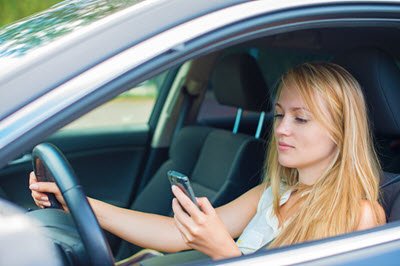
Written by Kayla Jane Barrie Updated on Sep 22, 2025 9 mins read

The dangers of texting and driving cannot be overstated. Texting while driving is a serious issue on roads. It is one of the leading causes of car accidents, injuries, and deaths on roadways.
Do you need to send that text right now – when driving? While we all know the answer to this question, countless drivers still choose to text while driving and put themselves and others in danger.
Texting and driving accidents happen all the time. On any given day, no matter where you are going, you can come across another driver texting and driving.
This post will discuss the dangers of texting and driving, look at statistics, facts, fines, and laws, and answer common questions about this dangerous driving practice. This risky behaviour can also affect your car insurance quotes.
Texting and driving is the act of writing, reading, and sending text messages or emails using your phone while driving a vehicle. It is a form of distracted driving, and it is illegal. Drivers caught texting while driving are subject to fines and demerit points.
This means you cannot use your phone when operating a vehicle. There is no sending, receiving or reading texts, checking email, or surfing the web. You could even get a ticket if you are holding your cell phone in your hand while driving, even if you are not using it. So, it’s best to put your phone away to avoid even the temptation of picking it up when behind the wheel.
Here are some very telling statistics on accidents caused by texting and driving:
Still not convinced about the dangers of texting while driving? Check out these texting and driving facts from TeenSafe:
Ontario's minimum fine for texting and driving is $615 for the first conviction. The maximum fine is $3000.
The texting and driving laws fall under the distracted driving laws in the province. If you are caught for texting and driving tickets, you are subject to the same penalties.
Drivers caught in their first texting and driving accident can expect these fines, according to the Government of Ontario. If you have an A, B, C, D, E, F, G and/or M licence, you’ll face bigger penalties when convicted of texting and driving:
First conviction
Second conviction
Third and any further conviction(s)
If you hold a G1, G2, M1 or M2 licence and are convicted of distracted driving, you’ll face the same fines as drivers with A to G licences. But you won’t receive any demerit points. Instead, you’ll face longer suspensions:
You may also be subject to a larger fine and additional charges, such as careless driving, if you are found to endanger others while texting and driving. If you are fined, you will likely see an impact on your car insurance from texting and driving.
Numerous texting while driving studies have been conducted, and it’s clear that getting a texting while driving ticket is not the only danger of using your phone when driving. You could get into an at-fault accident, lose control of your vehicle and cause serious injury or even kill someone – including yourself.
Getting a texting and driving ticket is only one of the many dangers of texting and driving :
Choosing to not text and drive is beneficial for you and all other drivers. Here are the top benefits of not texting and driving:
Texting and driving deaths are a serious issue. They are also preventable. In addition to causing more than half a million injuries each year, it’s estimated that about 11 teens die every day as a result of texting and driving. And this is just teens – about 4000 total deaths per year in the U.S.!
Source: www.edgarsnyder.com
If you witness a driver engaging in texting and driving or other dangerous driving actions, you can report them to your local police department. If you are driving on the highway, you can report them to the OPP.
If there is immediate danger, call 911. If there is no immediate danger, you can file a report on your local police station website. Make sure to get the vehicle details, including the license plate number.
Teens have become synonymous with texting and driving. A significant percentage of teen drivers are continuing to text and drive, despite the well-known dangers of the illegal activity.
The Ontario-based Centre for Addiction and Mental Health (CAMH) released a report indicating that a large percentage of students are texting and driving.
Dr. Robert Mann, Senior Scientist and Principal Investigator at CAMH, stated:
We asked about texting while driving because research shows this is very dangerous behaviour. We were surprised to find that so many young people take this risk.
In reporting on the results of the 2013 Ontario Students Drug Use and Health Survey (OSDUHS), a CBC article includes a link to video of CBC’s John Northcott, who comments on the numbers:
When you realize that the increase and the possibility of an accident when driving and texting increases twenty-fold, this is why they are concerned about this.
The irony here is that they seem to have the message on drinking and driving, yet they don’t realize that in terms of impairment, in terms of your ability to control the vehicle, texting is and can be just as bad as a few drinks,stated Mr. Northcott.
Another study, this one by Public Health Ontario, found a similar trend in the number of teens who text and drive. The study found:
Despite knowing the risks, many drivers continue to use their phones while driving. Here are some reasons why.
The Public Health Ontario study, while geared toward young drivers, still sheds some light as to why people still text and drive:
It is widely recognized that all forms of distracted driving are a safety risk. Here are some of the things that are being done about texting and driving:
Preventing texting and driving starts with you, the driver. It’s up to you to choose not to engage in texting and driving when you get behind the wheel. Therefore, the first thing you need to do is dedicate yourself to being a safe driver.
Here are some ways you can minimize the temptation to text and drive:
An additional texting and driving prevention tip is to use a prevention app. These apps can block calls, read texts and emails out loud, are hands-free, and offer customized options to ensure you do what is most important – focusing on driving.
You can use an app to turn off texting while driving. These apps are available for iPhone and Android devices. Apps to prevent texting are becoming more popular. Choose the app you find most effective.
If you have trouble keeping your hands off your phone when driving, try one of these apps:
Yes. It is illegal to text while at a red light, stop sign, and when stopped in traffic. You are not permitted to use your phone when your vehicle is in motion or stopped while driving.
Texting and driving has become the number one road safety risk today. It’s a leading cause of car accident injuries and deaths. Texting while driving is 6 times more likely to cause an accident than driving drunk. Fatalities related to drinking and driving are on the decline as deaths related to texting and driving are on the rise.
There are many ways police catch drivers who are texting and driving. They perform distracted driving blitz campaigns, rely on other drivers reports, and observe traffic.
Distracted driving, and the use of mobile devices while driving, officially became illegal in Ontario in 2009.
Many organizations encourage drivers to take a no texting while driving pledge. Have you taken the pledge? Even if you don’t formally take the pledge, you can commit to not texting while driving. Every driver who chooses to avoid the temptation to text will help make our roads safe for all.
| Categories | Auto |
|---|---|
| Tags | Auto Coverage |
Read our insurance blog to get helpful tips, information and news.
Drive safe this winter! Check out these tips for driving in snowy and icy conditions in Ontario. Get other helpful info and FAQs on winter driving.
Drive safer this winter. Learn how the right set of winter tires drastically reduces stopping distance and risk on ice and snow. Get expert tips from your trusted insurance provider.
Ontario municipalities have until November 14 to remove all automated speed enforcement cameras following fast-tracked provincial legislation. This post breaks down why the government is removing them, the pushback from road safety advocates, and what alternative measures will replace them.
What is specified perils insurance coverage? Learn about named perils policies for Ontario drivers. Get info about coverage, if you need it & answers to common questions.